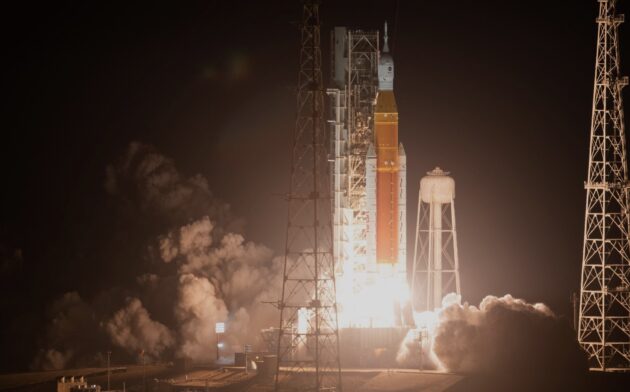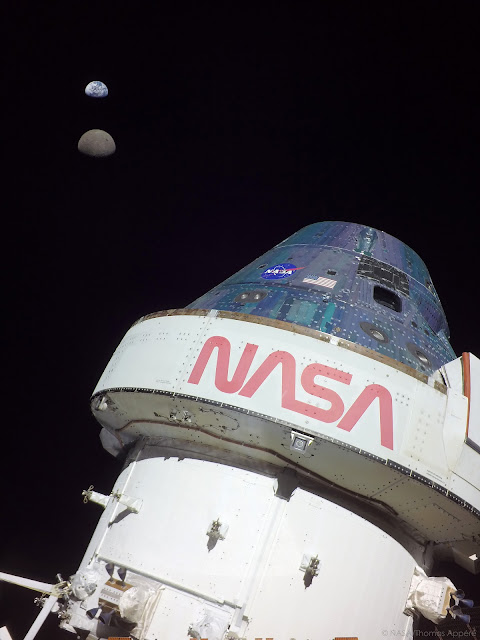On November 16th, after more than six years of problems, delays and cost overruns, to say nothing of two last minute hurricanes, NASA’s massive Space Launch System (SLS) with it’s Orion man capable capsule was finally launched from Cape Kennedy’s pad 39B. The Artemis 1 mission as the combination is officially designated is an unmanned test of the equipment that will in just a few years take human beings back to the Moon after a more than 50 year absence. In many ways Artemis 1, and its manned successor Artemis 2, are a reboot of the Apollo 8 mission that first took humans to orbit the Moon.

All of this was supposed to happen back in 2016, the huge SLS rocket that serves as the lunch vehicle was going to be easy to design and build. After all the main engines were the same RS25 engines that powered the space shuttle and the solid fuel boosters on each side of the rocket’s core stage were just longer versions of the shuttle’s solid fuel boosters. The problems just kept multiplying however and the delays, and cost overruns caused the program to take twice as long and cost nearly three times what was originally allocated.

Even once the SLS got to Cape Kennedy the problems continued to pile up with hydrogen fuel leaks alternating with the threat of hurricane winds to cause a series of small delays. Even on the day of launch itself a small hydrogen leak was detected after the SLS had been fueled that required a team of engineers to go out to the pad and tighten some valves on the rocket before liftoff.

Still when the countdown went to zero and the engines ignited the SLS, the most powerful rocket ever built, that’s in terms of initial thrust, performed flawlessly, lifting the Orion capsule, its European Service Module (ESM) along with an Interim Cryogenic Propulsion Stage into Earth orbit. So powerful was the takeoff that the mobile launch pad, which had carried Artemis back and forth to the Vehicle Assembly Building several times, was damaged.

Once Orion was in orbit the SLS had completed its task, ten years of costly development for a mere eight minutes of performance. Now the engineers will have to go over the data thoroughly but the big rocket certainly proved that it could do the job it was designed for. Approximately forty minutes after achieving orbit the Interim Cryogenic Propulsion Sage fired its engine for an eight minute burn that sent the Orion capsule and the ESM on an Earth escape trajectory to the Moon.

The rest of the mission is up to the Orion capsule and it’s service module, which was designed and built by the European Space Agency (ESA) as their contribution to the Artemis program. According to the mission plan the spacecraft was to pass behind the Moon and there perform a four minute burn of the ESM’s engine to place Orion in a lopsided retrograde orbit around the Moon that would bring the spacecraft closer than 100 kilometers to the Lunar surface and take it further than 60,000 kilometers. This burn was successfully carried out on the 21st of November.

O’k, so what’s a retrograde orbit and why it that important for Artemis? Well if you take your right hand, point your thump up while wrapping your fingers around, see image, and imagine that your thumb is the Sun’s north pole then virtually everything in our Solar System orbits, rotates, spins around the Sun in the direction your fingers point, their angular momentum is counter-clockwise.

Only a few objects, like the spin of Venus on its axis and several of Jupiter’s smallest, and farthest moons rotate in the opposite direction, clockwise and are said to have a retrograde motion. Now the engineers at NASA wanted Orion to be put into this unusual orbit in order to push it a bit, to see if the spacecraft and the ground systems tracking it, could handle the extra strain. This mission is intended to test the equipment after all.

So the plan was for Orion, with its ESM to orbit the Moon until the 1st of December when a final burn of the ESM’s engine set the spacecraft on a return path back to Earth. Reentry and splashdown are scheduled for December eleventh off the California coast in the Pacific Ocean.

If the mission ends as successfully as its gone so far then the Artemis 2 mission is scheduled for sometime in 2024. That mission will be manned and for the first time in fifty humans will return to Lunar Orbit although not actually land on the Lunar surface. That event is going to have to wait for Artemis 3 and the development of a landing module.

It’s been along time since humans last walked on the Moon but the Apollo program that put men on the Moon had no plan for a follow up, no intention of staying on the Moon. Artemis may be slower but it is designed as a step-by-step program leading to a permanent base on the Moon. This time we plan on staying.
